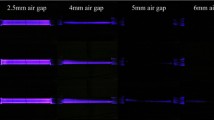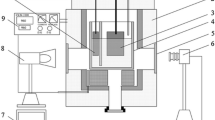Abstract
In this study, a traditional tubular reactor and an amplitude-modulated AC power supply were employed to develop a unique practical ozone generator with a widely adjustable ozone concentration and simultaneously a constant ozone yield. The characteristics regarding discharge and ozone generation in oxygen were experimentally investigated in detail. The amplitude-modulated AC waveform consisted of TON (burst of four consecutive AC cycles) and TOFF with a duty cycle of 0.4. The experimental results show that a unique ozone generator can be developed through changing the applied voltage amplitude when an amplitude-modulated AC power supply producing periodic bursts of several consecutive AC cycles during the TON period is used. A quite high and stable ozone yield of 165 ± 16 g/kWh was achieved and a wide range of ozone concentrations could be obtained. Moreover, we observed a very interesting phenomenon that the discharge energy and voltage peak for every AC cycle showed some difference, resulting from the accumulation and release of charge on the dielectric. The first AC cycle had the highest discharge energy and positive voltage peak as well as the lowest negative voltage peak, which was particularly obvious at a high energy density. Additionally, water cooling of the grounded electrode seemed to have a small influence on the basic electrical characteristics of the discharge and had a positive effect on the concentration and yield of ozone due to a reduction in gas temperature in the discharge gap.









Similar content being viewed by others
References
Eliasson B, Hirth M, Kogelschatz U (1987) J Phys D Appl Phys 20(11):1421–1437
Kogelschatz U, Eliasson B, Egli W (1997) J Phys IV France 7(C4):C4-47-C4-66
Kogelschatz U, Eliasson B, Egli W (1999) Pure Appl Chem 71(10):1819–1828
Kogelschatz U (2003) Plasma Chem Plasma Process 23(1):1–46
Kogelschatz U (2017) J Phys D Appl Phys 50:051001
Wei LS, Pongrac B, Zhang YF, Liang X, Prukner V, Šimek M (2018) Plasma Chem Plasma Process 38:353–364
Šimek M, Pekarek S, Prukner V (2010) Plasma Chem Plasma Process 30:607–617
Šimek M, Pekarek S, Prukner V (2012) Plasma Chem Plasma Process 32:743–754
Wagner HE, Brandenburg R, Kozlov KV, Sonnenfeld A, Michel P, Behnke JF (2003) Vacuum 71:417–436
Wei LS, Yuan DK, Zhang YF, Hu ZJ, Dong GP (2014) Vacuum 104:61–64
Mundy B, Kuhnel B, Hunter G, Jarnis R, Funk D, Walker S, Burns N, Drago J, Nezgod W, Huang J, Rakness K, Jasim S, Joost R, Kim R, Muri J, Nattress J, Oneby M, Sosebee A, Thompson C, Walsh M, Schulz C (2018) Ozone Sci Eng 40(4):266–274
USEPA (2010) Long Term 2 Enhanced Surface Water Treatment Rule Toolbox Guidance Manual (EPA 815-R-09-016). https://nepis.epa.gov/Exe/ZyPDF.cgi?Dockey=P1009JLI.txt. Accessed 31 May 2018
Acknowledgements
This work was supported by the Czech Science Foundation (GA15-04023S), National Natural Science Foundation of China (51867018 and 51711530316) and Natural Science Foundation for Distinguished Young Scholars of Jiangxi Province, China. L. S. WEI would like to thank the NSFC-CAS agreement for funding his stay at IPP Prague.
Author information
Authors and Affiliations
Corresponding author
Rights and permissions
About this article
Cite this article
Zhang, Y.F., Wei, L.S., Liang, X. et al. Characteristics of the Discharge and Ozone Generation in Oxygen-Fed Coaxial DBD Using an Amplitude-Modulated AC Power Supply. Plasma Chem Plasma Process 38, 1199–1208 (2018). https://doi.org/10.1007/s11090-018-9922-2
Received:
Accepted:
Published:
Issue Date:
DOI: https://doi.org/10.1007/s11090-018-9922-2




